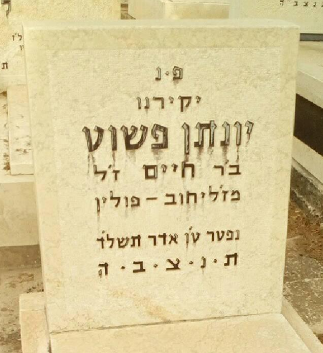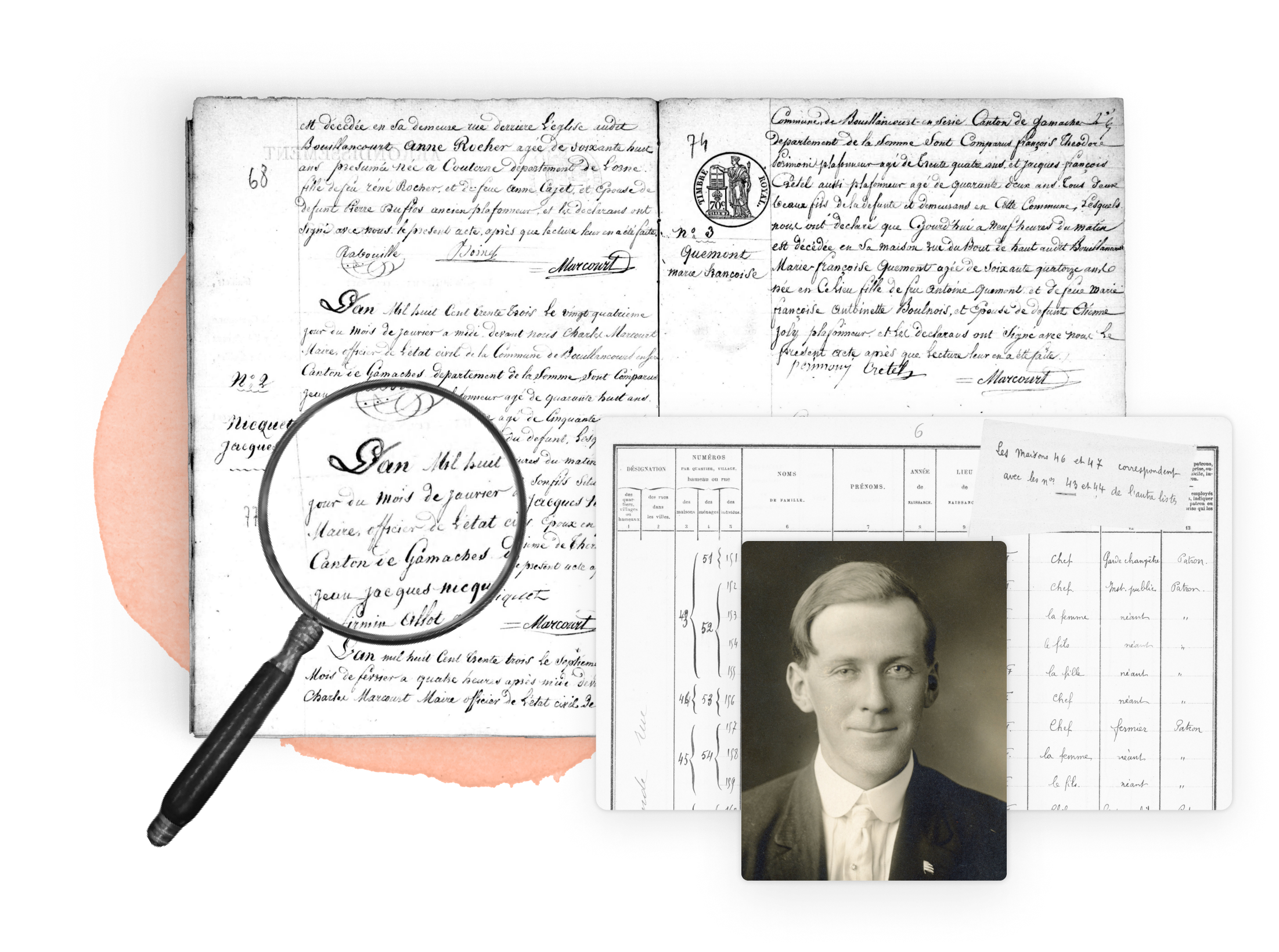There are over 1.5 million graves in Israel, in 638 cemeteries spread throughout the country. The largest of all of them, the Holon Cemetery, contains over 200,000 graves, which have all been digitized as part of a project led by MyHeritage as part of an effort to document grave records in Israel with the collaboration of members of the Israeli society. Another remarkable cemetery in Israel is the Mount of Olives Cemetery, which holds approximately 150,000 graves and has been used as a Jewish cemetery for over 3,000 years, thus making it central to the tradition of Jewish cemeteries.[1]
For thousands of years, people of different faiths and backgrounds have been buried in the Holy Land, due to its religious importance for the world's largest monotheistic religions. Even before the State of Israel was created in 1948, religious Jews from all over the world used to travel there to spend their last years and eventually be buried in the Mount of Olives Cemetery, the oldest cemetery in the world in continuous use. Likewise, Christian pilgrims came to the Holy Land looking for traces of Jesus, places associated with the New Testament, where saints and apostles lived, and where miracles took place. If they died while still in the Holy Land, pilgrims were buried according to their religion, in separate cemeteries that exist to this day, and which are now public and easy to search online. Apart from the military cemeteries administered by the Israel Defense Forces, there are also three military cemeteries whose grounds were assigned to the United Kingdom for the burial of Commonwealth servicemen who fell since World War I in the region, one in Ramla and two in Jerusalem. One of these cemeteries, the Indian War Cemetery, contains the tombs of 290 Ottoman prisoners of war.[2]
Research your ancestors on MyHeritage
Digitization of graves in Israel
After 5 years of dedicated efforts, with the help of the BillionGraves platform and more than thirty thousand volunteers, MyHeritage completed the digitalization of all the cemeteries in Israel[1] and published this collection on its website in 2019 to make it searchable online. Though it does not contain records of all the graves that exist in Israel — as new burials occur daily, unfortunately — it is updated regularly. This collection contains over 3 million images of graves from 138 cemeteries throughout Israel of different faiths such as Jewish, Christian, Greek-Orthodox, Catholic, and Muslim, many of which have been partially transcribed.
Generally, these gravestones contain the first and last names of the deceased and their date of death. Depending on the person’s faith and the time period, they may also include further details such as the birth date, birthplace, age at death, immigration date, names of father, mother and/or grandfather, spouse, profession, military rank, tribe, names of close relatives who were lost in the Holocaust, among many other facts. This collection constitutes a very important place in Israeli genealogy since it is, for many people, the first place to go when starting a family tree or when researching a deceased person.
Searching for grave records
The images of the graves and their partial transcription can be found on MyHeritage. Additionally, MyHeritage offers a search widget to search in its collection of grave records: Another recommended resource is the GRAVEZ website. While this platform contains only around one million grave records from close to 80 cemeteries, in contrast to the 3 million grave records from 138 cemeteries offered by MyHeritage, it works together with the Association of Burial Societies in Israel, which are responsible for the burial services in Israel and keep records of their own. Therefore, some details from their records are included on the website, which are not available anywhere else.
Miscellaneous details found in Israeli gravestones
By looking at the grave of Betzalel Gluzman, for example, other personal details can be found: Most of the graves start with the Hebrew acronym P”N or פ”נ. This acronym constitutes two words “Po Nikbar”, which means “Here lies…”
Jewish gravestones also provide details on who the buried person was. In the above example, it says “Avi HaYakar” (My Dear Father), which provides a very important piece of information: the deceased person had a child. If the person had more than one child, it would say “Avinu HaYakar” (Our Dear Father). Nowadays, it is customary to add all the family titles a deceased person had, such as husband, brother, father, grandfather, great-grandfather, uncle, and so on.
If the person died single and with no family, it may say “Ahuvenu” (Our beloved), “Chavrenu” (Our friend), or “Yekirenu” (Our Dear), can be seen in the below grave of Yonatan Pashut:

Right after the title of the person, comes the name of the deceased and then the name of their father. Traditionally, Ashkenazi Jews write the name of the father of the deceased on the grave, while Sephardic Jews write the name of the mother of the deceased. While many still carry on that custom, it has become an Israeli tradition to add both the names of the father and the mother of the deceased. In Yonathan Pashut’s grave, for example, which reads “Yonathan Pashut son of Mr. Chaim,” Ashkenazi tradition was followed, where only the father is mentioned.
In contrast, in “newer” graves like the one below, belonging to Yitzhak Ahituv, both of his parents’ names appear as “Leah and Mordechai.”

The Israeli tradition of having both parents’ names of the deceased engraved began with military graves and eventually spread to regular graves. On both types of graves, the mother is mostly mentioned first, and then the father. More personal details are usually added after the names of the parents. These details can vary, depending on what the relatives of the deceased wanted to add. The only details that are fixed are the Hebrew passing date and the traditional inscription “T.N.Tz.B.H.” or ת.נ.צ.ב.ה. This inscription is an acronym for “May his soul be bound in the bond of life,” which in Hebrew reads תהיה נשמתו צרורה בצרור החיים
As can be seen in Yonatan Pashut's grave, the only additional detail that was added was his origin: it says that he was born in the town of Zelechow in Poland.

On Betzalel Gluzman's grave, on the other hand, it was added “Born in 5655” (Hebrew year corresponding to 1894-1895) and “Immigrated to Israel in 5705” (1944-1945).
Nowadays, many also add Gregorian calendar dates besides the Hebrew calendar dates in Hebrew letters in order to so make the information easier to read. We can see an example of that in the following grave, belonging to Mendel Gerecht, where his relatives wrote “1919-1999”. Since graves today are not only standing pieces of stone but may also be flat-lying stones, relatives of the deceased have more room to write details. For individuals who lost close relatives in the Holocaust, after passing away their family uses the grave as a place where they could have their ancestors' names written and remembered since they didn't receive a proper burial or have a gravestone for themselves.

It reads: “Also in memory of his parents Bluma and Moshe, his sister Faiga and his brother Eli who perished in the Holocaust.”
Other graves may include the profession of the deceased, like the one below, belonging to the singer Arik Einstein, which titles him as “producer, singer and actor”:

Military graves in Israel
A separate category of graves in Israel is that of fallen soldiers. These military graves are smaller than regular graves, which means there is space to write personal details on them. However, they are roughly standardized both in shape and content. The details contained in them include the IDF emblem, military rank, military ID number, first and last name, names of parents, birthplace, birthdate (not always), immigration year (if applicable), death circumstances (which military operation or war), passing date, and age, as can be seen in the grave below, belonging to the soldier Chanan Ben-Shalom:

From the above-mentioned pattern, Ben-Shalom’s grave includes:
- IDF emblem
- Military rank: Corporal
- Military ID number: 434931
- First and last name: Chanan Ben-Shalom
- Names of parents: Son of Naomi and Yehudah
- Birthplace: Born in Degania Bet
- Death circumstances: Fell in a battle next to Tel-Katzir
- Passing date: 3rd of Shevat, 5720
- Age: 19
Another example that does include the details that are missing here is the grave of the soldier Melech (Michael) Levin:

- IDF emblem
- Military rank: Staff Sergeant
- Military ID number: 6196337
- First and last name: Melech (Michael) Levin
- Names of parents: Son of Hinda Leah and Meir HaCohen
- Birthplace: Born in the United States
- Birthdate: On the 14th of Adar A 5744, 17.2.1984
- Immigration year: Immigrated to Israel on 5763, 2003
- Death circumstances: Fell in a battle in the South of Lebanon during the Second Lebanon War
- Passing date: 7th of Av, 5766 (1.8.2006 in the Gregorian Calendar)
- Age: 22
References
- ↑ 1.0 1.1 The Jewish Cemetery on the Mount of Olives
- ↑ JERUSALEM INDIAN WAR CEMETERY. Commonwealth War Graves Commission


